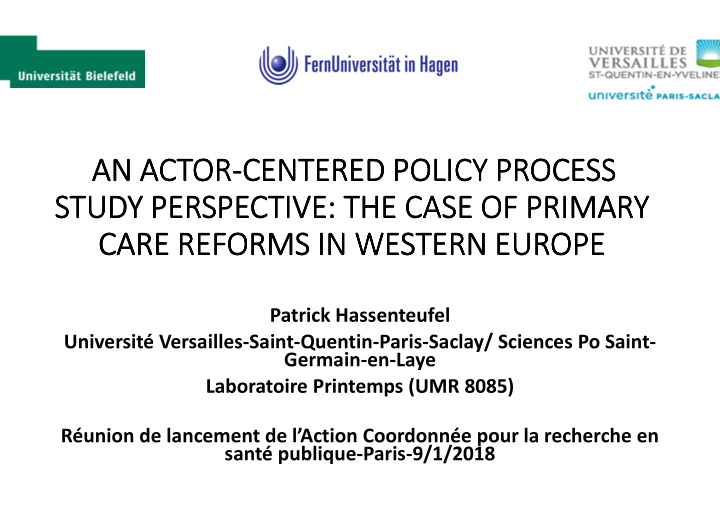



AN AN AN ACTOR AN ACTOR ACTOR ACTOR- - - -CENTERED POLICY PROCESS CENTERED POLICY PROCESS CENTERED POLICY PROCESS CENTERED POLICY PROCESS STUDY PERSPECTIVE: THE CASE OF PRIMARY STUDY PERSPECTIVE: THE CASE OF PRIMARY STUDY PERSPECTIVE: THE CASE OF PRIMARY STUDY PERSPECTIVE: THE CASE OF PRIMARY CARE REFORMS IN WESTERN EUROPE CARE REFORMS IN WESTERN EUROPE CARE REFORMS IN WESTERN EUROPE CARE REFORMS IN WESTERN EUROPE Patrick Hassenteufel Université Versailles-Saint-Quentin-Paris-Saclay/ Sciences Po Saint- Germain-en-Laye Laboratoire Printemps (UMR 8085) Réunion de lancement de l’Action Coordonnée pour la recherche en santé publique-Paris-9/1/2018
presentation based on the REGMEDPROV (Ensuring access t edical provision in disadvantaged regions) research project A French (P. Hassenteufel/FX Schweyer)-German (T. Gerlinger/R. Reiter) research team co-financed by the ANR and the DFG A comparison between 4 different healthcare systems (National Health Service/Health Insurance ; centralized/decentralized) : England, Sweden, France, Germany A mix of qualitative methods (interviews of the different stakeholde and systematic public documents analysis) combining case studies o national and regional levels (France : Bretagne and Rhône- Alpes/Germany : Mecklenburg-Vorpommern and Westfalen-Lippe) i order to understand the policies tackling the issue of territorial inequalities in access to primary care
policy studies perspective focused on policy actors (their trategies in relation with their resources, representations and urposes, so as the interactions between them) ain differences with Health Service Research Different research question : we try to explain policy changes (more than the impact of medical practice) Different disciplinary background : political science and sociology more than clinical epidemiology and health economics) Different level of analysis : healthcare systems (more than delivery systems) Different focus of analysis : policy problem framing, policy choices and policy outputs (more than policy outcomes)
hat we have analyzed yet (and some preliminary findings): Differences in the framing of the issue of medically underserved territories Different interactions in the policy instrument choice process Changes in the organization of primary care (role of actors promoting change) The territorialization of primary care policies (at different levels) A diverging convergence process in primary care organization
1. The framing of the issue of medically underserved territories A similar shift from the perception of an over supply of physicians to the concern of local shortage of physicians in Germany ( Ärztemangel ) and France ( Déserts médicaux ) in the early 2000’s: a key issue on the health policy agenda In England a long term perception of an overall shortage of general practitioners and other health professionals (core issue of waiting times), territorial dimension more focused on variations in quality, political debate: market reforms/increase public funding In Sweden the more recent comeback of the issue of territorial inequalities (before: waiting times) as a consequence of the 2010 market reform: privatizatio of primary health care centers (politicization) Role of 3 kinds of actors: provider’s associations, political actors (local and national) and experts (debate on the measurement of territorial inequalities in access to primary care)
. Different interactions in the policy instrument choice proces In France and Germany: conflicts between the State and the medica profession explain the adoption of two kinds of instruments (limited instrumental change) inancial incentives : extra payment, new contracts, specific rules … ather than constraints, i.e. settlement restriction in over-served areas egulation of Medical Education and Careers: raising the number of edical students, strengthening primary care in medical training, elaying physician’s retirement’s age In England and Sweden a more politicized debate concerning marke reforms
. The issue of territorial inequalities as a window of opportunity for chang in the organization of primary care Dimensions of change w cooperative health structures: Multi-professional health centers (MSP) in France, edical provision centers (MVZ) in Germany, Health centers and walk-in centers in gland, New model of rural medicine in Sweden ( Glesbydsmedicin ) tending the role of other health professionals: especially nurses (also pharmacists), eation of new health professions (consultant therapist in England, clinical nurse in ance, ) creased coordination between outpatient care, hospitals and social services velopment of new way of working and service delivery: telecare, online-consultation ctronic prescriptions… The role of actors promoting change : medical entrepreneurs (case of the FFMPS i France), State experts
4.The territorialization of primary care policies In France : key role of the (State led) Regional Health Agencies in France (created in 2009) In Germany the reinforcement of the regional actors (2011 and 201 Acts): Regional Physician’s Unions (KV), Regional Sickness Funds Associations, Länder In Sweden : key role of the counties (with territorial political differences : South/North, urban/rural) In England : creation of new local structures in relation to market reforms (Clinical Commissioning Groups) and more recently local experimentations to increase coordination (in the NHS and between NHS and community services: vanguard sites)
. A diverging convergence process (Levi-Faure/Jordana 2005) in rimary care organization Path-dependency of national healthcare systems and actors : the selection and definition of policy problems and most elements of the policy strategies pursued reflect established institutional structures of the respective healthca systems and depend on the established relations between policy actors Indications of a certain convergence of the four healthcare systems towards more decentralized regulation and local coordination of services and health professions (use of similar policy instruments), partly blurring the differences between NHS and HIS healthcare systems
Thank you for your attention! www.medical-provision.eu
Recommend
More recommend